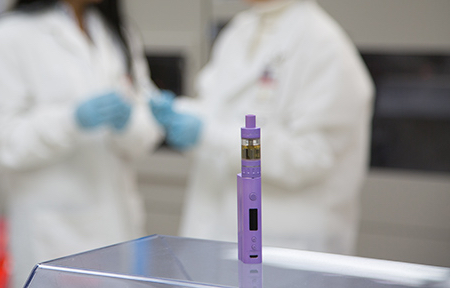Findings of a research team at the VA San Diego Healthcare System in La Jolla, California, contribute to a growing body of evidence pointing to possible health risks — especially concerning cancer — associated with electronic cigarettes.
The San Diego investigators tested the cytotoxicity and genotoxicity of short- and long-term e-cigarette vapor exposure on a panel of normal epithelial and head and neck squamous cell carcinoma (HNSCC) cell lines, and found that e-cigarette use damaged cells in ways that could lead to cancer, with the damage shown to occur even with nicotine-free versions of the products.
“Our study strongly suggests that electronic cigarettes are not as safe as their marketing makes them appear to the public,” wrote the researchers, according to a news release. The team published it findings in the January 2016 edition of the journal Oral Oncology, under the title “Electronic cigarettes induce DNA strand breaks and cell death independently of nicotine in cell lines.“
 E-cigarettes were the target of lab investigations at the VA San Diego Healthcare System. (Photo Credit: Kevin Walsh)
E-cigarettes were the target of lab investigations at the VA San Diego Healthcare System. (Photo Credit: Kevin Walsh)
“There haven’t been many good lab studies on the effects of these products on actual human cells,” said Dr. Jessica Wang-Rodriguez, a professor of pathology at UC San Diego, chief of pathology and laboratory medicine at the San Diego VA, and one of the study’s lead co-authors.
Researchers Find Vapor-Exposed Cells More Likely to Die
In their lab research, Dr. Wang-Rodriguez’s team created an extract from the vapor of two popular brands of e-cigarettes, and treated human cells with that extract. They found that compared with untreated cells, the vapor-treated cells were more likely to show DNA damage and die.
The team reported that exposed normal and HNSCC cell lines showed several forms of damage, including DNA strand breaks, explaining that when one or both of the DNA strands break apart and the cellular repair process doesn’t work properly, the stage is set for cancer development. They also found that the affected cells had significantly reduced cell viability and clonogenic survival, and were more likely to launch into apoptosis and necrosis, both of which lead to cell death. For the main part of their experiment, the research team used normal epithelial cells, which line organs, glands, and cavities throughout the body, including the mouth and lungs.
Nicotine Is Not the Main Culprit
The VA San Diego scientists tested two types of each e-cigarette: a nicotine and a nicotine-free version. Nicotine is the element in tobacco that makes smoking addictive. The team found that the nicotine versions of e-cigarettes caused more severe damage, but even nicotine-free vapor had a cell-altering effect.
 “There have been many studies showing that nicotine can damage cells,” said Dr. Wang-Rodriguez. “But we found that other variables can do damage as well. It’s not that the nicotine is completely innocent in the mix, but it looks like the amount of nicotine that the cells are exposed to by e-cigarettes is not sufficient by itself to cause these changes. There must be other components in the e-cigarettes that are doing this damage. So we may be identifying other carcinogenic components that are previously undescribed.”
“There have been many studies showing that nicotine can damage cells,” said Dr. Wang-Rodriguez. “But we found that other variables can do damage as well. It’s not that the nicotine is completely innocent in the mix, but it looks like the amount of nicotine that the cells are exposed to by e-cigarettes is not sufficient by itself to cause these changes. There must be other components in the e-cigarettes that are doing this damage. So we may be identifying other carcinogenic components that are previously undescribed.”
The team is now trying to sort out those other substances and their specific effects. For example, scientists already know of some troubling chemicals in the products, particularly formaldehyde, a known carcinogen. The researchers noted that using e-cigarette products at low voltage settings may minimize formaldehyde production. Another possible culprit is the flavoring agent diacetyl, which has been linked to lung disease — a Harvard study found it to be present in more than three-quarters of flavored e-cigarettes and refill liquids, a.k.a., “e-juice.”
With nearly 500 brands of e-cigarettes on the market being sold in more than 7,000 flavors, scientists have their work cut out to identify all potential problems. “For now, we were able to at least identify that e-cigarettes on the whole have something to do with increased cell death,” said Dr. Wang-Rodriguez. “We hope to identify the individual components that are contributing to the effect.”
Study Did Not Mimic Actual Doses
Dr. Wang-Rodriguez noted that cells in the lab are not entirely comparable to cells within a living person, and that the cell lines scientists work with have been “immortalized because of certain cell changes.” Consequently, she suggests that e-cigarette vapor could have different effects inside the human body than those seen in the lab. Also, her team didn’t seek to mimic the actual dose of vapor an e-cigarette user would get.
“In this particular study, it was similar to someone smoking continuously for hours on end, so it’s a higher amount than would normally be delivered,” explained Dr. Wang-Rodriguez. “What we’re looking at now is to dose-control these. We want to know at what dose it causes that critical switch-over to where we see the damage.”
While the U.S. Food and Drug Administration (FDA) does not regulate e-cigarettes as it does conventional tobacco products, the agency has warned about possible health risks associated with their use. Researchers noted that, at this point, evidence is limited on what exactly e-cigarettes contain and whether those chemicals are safe, particularly in terms of cancer risk.
The team emphasized that further assessment of the potential carcinogenic effects of e-cigarette vapor is urgently needed, with the operative question — are battery-operated vaporizer products are any safer than the conventional tobacco cigarettes they are designed to replace — still unanswered. Dr. Wang-Rodriguez doesn’t think they are. “Based on the evidence to date,” she said, “I believe they are no better than smoking regular cigarettes.”
This work was funded by the Department of Veterans Affairs, National Institutes of Health, and the Brandon C. Gromada Head and Neck Cancer Foundation.
Sources:
U.S. Department of Veterans Affairs
Oral Oncology
VA San Diego Healthcare System

